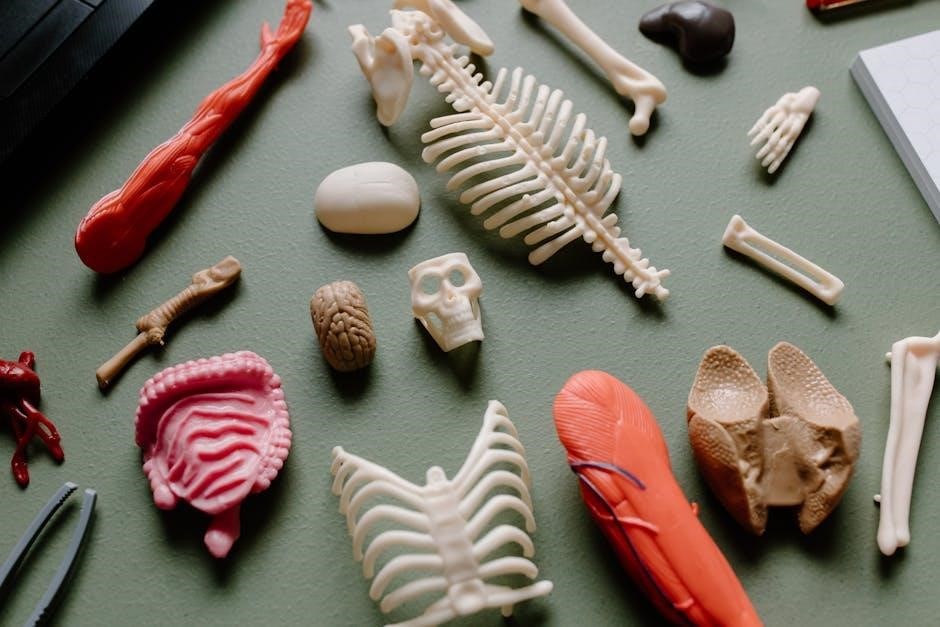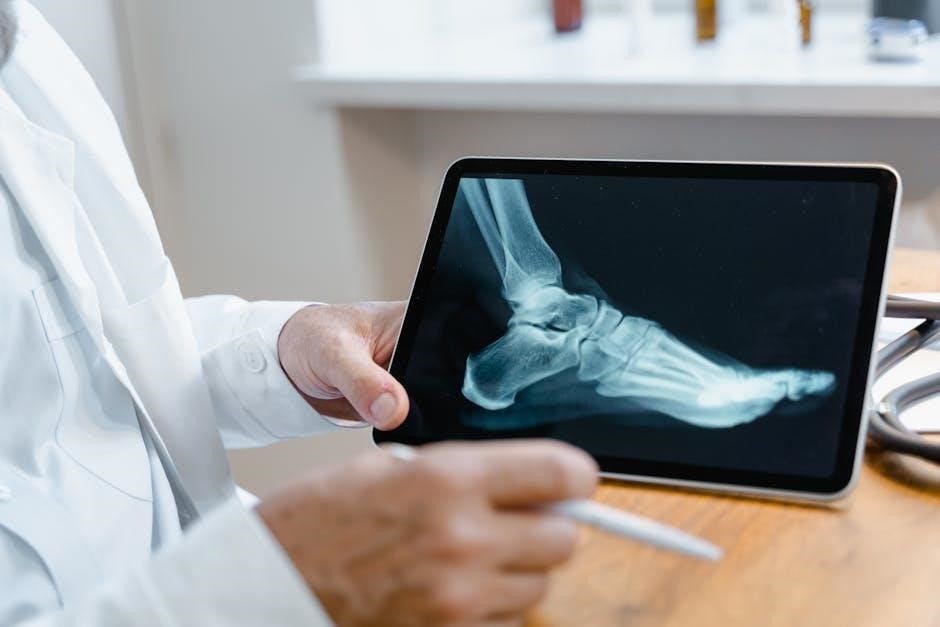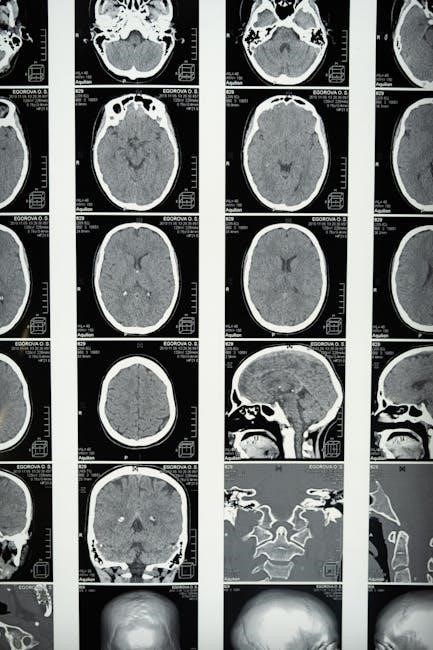The Human Anatomy & Physiology Laboratory Manual, Cat Version, provides a comprehensive guide for healthcare and biology students, featuring dissection exercises, histology labs, and physiological experiments.
1.1 Overview of the Lab Manual
The Human Anatomy & Physiology Laboratory Manual, Cat Version, is a comprehensive resource for two-semester A&P courses, pairing with Mastering A&P for enhanced learning. It features diverse exercises, including dissection, histology, and physiology labs, designed to align with any A&P textbook. The manual is renowned for its clear instructions, full-color artwork, and logical organization, making it an essential tool for both students and instructors.
1.2 Importance of the Cat Version in Anatomy & Physiology Studies
The Cat Version is a cornerstone in anatomy and physiology education, offering a detailed dissection model that closely mirrors human anatomy. Its structured exercises and visual aids enhance understanding of complex systems, making it indispensable for healthcare students. The integration with Mastering A&P further solidifies its role in modern A&P training, ensuring practical and theoretical mastery for future professionals.

Structure and Organization of the Lab Manual
The manual is logically organized by body systems, aligning with Marieb’s textbook and featuring full-color art. It includes pre-lab and post-lab resources, enhancing structured learning.
2.1 Chapter Breakdown and Key Features
The manual is divided into chapters corresponding to body systems, each containing detailed exercises, illustrations, and digital resources. Key features include full-color artwork, pre-lab and post-lab assignments, and integration with Mastering A&P for enhanced learning. The clear organization aligns with Marieb’s textbook, while the variety of exercises caters to different learning styles, ensuring comprehensive understanding of anatomy and physiology concepts;
2.2 Integration of Artwork and Visual Aids
The manual incorporates detailed, full-color artwork from Marieb and Hoehn, enhancing visual learning. Illustrations, diagrams, and dissection images are carefully designed to clarify complex anatomical structures. Digital integration with Mastering A&P further enriches the learning experience, offering interactive tools and labeled figures that complement the textbook and lab exercises, ensuring a comprehensive understanding of human anatomy and physiology.

Key Exercises and Activities in the Cat Version
The Cat Version offers hands-on exercises, including dissections and physiological experiments, designed to enhance understanding of human anatomy and physiology through practical application and observation.
3.1 Dissection Exercises
Dissection exercises in the Cat Version provide detailed hands-on experience, focusing on identifying organs and systems. These exercises align with human anatomy, offering a comparative perspective to enhance understanding of physiological processes and anatomical structures. Full-color illustrations and step-by-step instructions guide students, ensuring a comprehensive learning experience that bridges theory with practical application.
3.2 Histology and Microscopy Labs
Histology and microscopy labs in the Cat Version focus on examining tissue structures under a microscope. Students analyze slides to identify cellular features and their functions. Full-color micrographs and guided activities enhance understanding of human histology, with exercises designed to improve critical thinking and practical skills in tissue identification and physiological processes. These labs are essential for connecting anatomical structures to their functional roles.
3.3 Physiological Experiments
Physiological experiments in the Cat Version engage students in hands-on activities that explore bodily functions. Exercises include measuring reflexes, analyzing nerve responses, and studying muscle physiology. These experiments complement dissection and histology work, offering a dynamic approach to understanding how systems interact. Real-time data collection and analysis tools enhance learning, making complex concepts more accessible and engaging for students.
Supporting Resources for Students and Instructors
The manual offers pre-lab and post-lab assignments, digital tools, and integration with Mastering A&P, providing students and instructors with comprehensive support to enhance learning and time management.
4.1 Pre-Lab and Post-Lab Assignments
The pre-lab and post-lab assignments in the Cat Version manual are designed to enhance preparation and reinforce learning. These include pre-lab videos, vocabulary coaching, and art labeling activities to engage students. The assignments integrate seamlessly with Mastering A&P, offering interactive tools and assessments. They also provide structured review sheets for self-study, ensuring a comprehensive understanding of lab exercises and clinical applications. Instructors can customize assignments through Pearson Collections to meet specific course needs, making the resources highly flexible and effective for both students and educators.
4.2 Digital Tools and Mastering A&P Integration
The Cat Version integrates seamlessly with Mastering A&P, offering pre-lab videos, bone and muscle videos, and Dynamic Study Modules. Digital tools like Practice Anatomy Lab 3.1 and art labeling activities enhance engagement. These resources provide interactive learning opportunities, aligning with lab exercises and clinical applications. The integration supports personalized learning, making complex concepts more accessible and improving student outcomes in anatomy and physiology studies.

Comparison with Other Versions (Main and Fetal Pig)
The Cat Version offers unique dissection exercises, aligning closely with human anatomy, while the Main and Fetal Pig versions provide alternative perspectives for comparative learning experiences.
5.1 Unique Features of the Cat Version
The Cat Version stands out with its detailed dissection exercises, offering a comprehensive understanding of mammalian anatomy. Its alignment with human physiology makes it ideal for healthcare students. The manual includes full-color artwork and integrates with Mastering A&P, enhancing interactive learning. Additionally, it provides clinical application questions and critical thinking exercises, fostering practical relevance and deeper comprehension of physiological processes. This version is particularly praised for its organized structure and supplementary digital tools, making it a valuable resource for both students and instructors in anatomy and physiology education.
5.2 Differences in Dissection and Lab Experiments
The Cat Version emphasizes detailed dissection exercises tailored to mammalian anatomy, offering a cost-effective alternative to human cadavers. It includes bone identification and muscle dissection labs, aligning with human physiology. Unlike other versions, it integrates pre-lab videos and digital tools, enhancing engagement. Its focus on clinical relevance and critical thinking sets it apart, providing a comprehensive learning experience for anatomy and physiology students.

Clinical Applications and Relevance
The Cat Version lab manual connects dissection and lab work to real-world clinical scenarios, preparing students for healthcare careers through case studies and critical thinking exercises, enhancing practical understanding and application.
6.1 Connecting Lab Work to Real-World Scenarios
The Cat Version lab manual bridges the gap between theoretical learning and practical application by incorporating case studies and clinical scenarios, enabling students to understand how anatomical and physiological concepts apply to real-world medical situations, enhancing their ability to think critically and prepare for healthcare careers.
6.2 Case Studies and Critical Thinking Exercises
The manual includes case studies and critical thinking exercises that simulate real-world clinical scenarios, challenging students to apply anatomical and physiological knowledge. These exercises enhance problem-solving skills, preparing students for diagnosing and treating conditions in clinical settings. They reinforce learning by connecting lab work to practical patient-care situations, fostering a deeper understanding of human body functions and their implications in healthcare.

Benefits for Healthcare and Biology Students
The manual enhances skill development in anatomy and physiology, preparing students for clinical settings through hands-on dissection and physiological experiments, aligning with healthcare and biology career paths.
7.1 Skill Development in Anatomy and Physiology
The lab manual fosters proficiency in identifying anatomical structures and understanding physiological processes. Through dissection, histology, and experiments, students master practical skills, enhancing their ability to correlate structure with function. This hands-on approach ensures a deep comprehension of human systems, preparing students for professional demands in healthcare and research. The exercises are designed to build confidence and precision in scientific techniques.
7.2 Preparation for Clinical Settings
The lab manual equips students with practical skills and clinical relevance, preparing them for healthcare careers. Exercises emphasize anatomical identification, physiological measurements, and case studies, mirroring real-world scenarios. This training enhances diagnostic and procedural confidence, ensuring students are well-prepared to apply their knowledge in professional clinical environments, bridging the gap between academic learning and practical healthcare applications.
History and Evolution of the Lab Manual
The Human Anatomy & Physiology Laboratory Manual, Cat Version, has evolved over editions, with the 13th edition featuring enhanced visuals and digital tools, reflecting its commitment to modernizing anatomy education.
8.1 Development of the Cat Version
The Cat Version of the lab manual was developed to provide a practical, cost-effective alternative for anatomy dissections. It aligns with the main textbook’s content while offering species-specific exercises. Authors Elaine Marieb and Lori Smith collaborated to ensure its relevance for healthcare students, incorporating detailed dissection guides and clinical correlations to enhance learning outcomes.
8.2 Updates in the 13th Edition
The 13th Edition of the Cat Version introduces new full-color figures and enhanced clinical application questions. It includes additional pre-lab videos and interactive tools via Mastering A&P, improving student engagement and understanding. The updates aim to better integrate lab activities with classroom learning, ensuring a cohesive educational experience for anatomy and physiology students.
Author Contributions and Expertise
Elaine N. Marieb and Lori A. Smith bring extensive expertise in anatomy and physiology, combining academic and clinical insights to create a student-focused, accessible laboratory manual.
9.1 Elaine N. Marieb’s Role in the Manual
Elaine N. Marieb played a pivotal role in shaping the manual, blending her scientific expertise with clinical insights to create accessible, student-centered content. Her unique background in zoology and nursing enabled her to bridge the gap between anatomy and physiology, making complex concepts understandable for learners. Her contributions emphasize real-world applications, fostering a deeper understanding of human biology.
9.2 Lori A. Smith’s Contributions
Lori A. Smith brought her expertise in biochemistry and teaching to the manual, co-authoring it with Elaine Marieb. Her background in research and education enriched the content, particularly in physiology and biochemistry. Smith’s passion for teaching anatomy and physiology to pre-nursing students ensured the manual’s clarity and relevance, making complex concepts accessible for learners. Her contributions reflect a commitment to student-centered education.

Digital and Print Format Options
The Human Anatomy & Physiology Laboratory Manual, Cat Version, is available in both digital (Kindle) and print formats, offering flexibility for students to access content anytime, anywhere.
10.1 Kindle Edition and Accessibility
The Kindle edition of the Human Anatomy & Physiology Laboratory Manual, Cat Version, offers a digital format with features like highlighting, note-taking, and search functionality. It is accessible on select devices and requires the latest Kindle app. Despite its large file size, the eTextbook provides flexibility for students to study on-the-go, with a 4.5-star rating and positive feedback on clarity and organization, though some users reported issues with missing pages.
10.2 Print Edition Features and Benefits
The print edition of the Human Anatomy & Physiology Laboratory Manual, Cat Version, is highly regarded for its clear layout and full-color illustrations. It includes perforated pages for easy tear-outs, making it convenient for lab work. While some users noted issues with page perforations and binding, the manual remains a valuable resource for hands-on learning, with many praising its organization and effectiveness in supplementing coursework.

Student and Instructor Feedback
Students praise the manual’s clear illustrations and organization, while some note issues with missing pages and binding. Instructors appreciate its alignment with course objectives.
11.1 Reviews and Ratings
The Human Anatomy & Physiology Laboratory Manual, Cat Version, holds a 4.5-star rating on Amazon, with students praising its clear illustrations and organized exercises. Many reviewers highlight its effectiveness in supplementing coursework, with 90% of feedback positive on content quality. However, some users noted issues with missing pages and binding. Despite this, it remains a best-selling resource for anatomy and physiology education, widely adopted for its clarity and practicality.
11.2 Common Praise and Criticisms
The Human Anatomy & Physiology Laboratory Manual, Cat Version, is widely praised for its clear illustrations, organized exercises, and effectiveness in supplementing coursework. Many users appreciate its value for money and the ability to use it alongside other textbooks. However, criticisms include missing pages, binding issues, and some post-lab questions lacking clear answers, which can hinder student progress and understanding.
Customization and Supplemental Materials
The Human Anatomy & Physiology Laboratory Manual, Cat Version, offers Pearson Collections and additional resources, enhancing customization and integration with Mastering A&P for a comprehensive learning experience.
12.1 Pearson Collections and Additional Resources
Pearson Collections allows instructors to customize content, creating tailored resources for their courses. The Human Anatomy & Physiology Laboratory Manual, Cat Version, integrates seamlessly with Mastering A&P, offering pre-lab videos, coaching activities, and art labeling exercises. These resources enhance interactive learning and provide a seamless correlation with the lab manual, ensuring a comprehensive educational experience for students.
12.2 Alignment with Mastering A&P
The Human Anatomy & Physiology Laboratory Manual, Cat Version, aligns seamlessly with Mastering A&P, Pearson’s online learning platform. It offers pre-lab videos, Dynamic Study Modules, and art labeling exercises, enhancing interactive learning. Assignments are correlated with the manual, making it easier for instructors to create homework that reinforces lab activities, ensuring a cohesive and effective learning experience for students.

The Role of Dissection in Learning
Dissection in the Cat Version enhances hands-on understanding of anatomy, providing a practical approach to studying structures and systems, closely mirroring human anatomy for effective learning.
13.1 Advantages of Cat Dissection
Cat dissection offers a cost-effective and ethically acceptable model for studying anatomy. The cat’s body structure closely resembles human anatomy, making it an excellent teaching tool. It provides hands-on experience with organ systems, muscles, and tissues, enhancing spatial and functional understanding. The cat’s size and accessibility make it ideal for detailed dissection, allowing students to explore complex anatomical relationships in a practical and engaging manner.
13.2 Ethical Considerations and Alternatives
Ethical concerns in cat dissection include the sourcing of specimens and the impact on animal welfare. Alternatives such as virtual dissection software and 3D models provide immersive learning experiences without the need for animal specimens. These tools are increasingly popular, offering cost-effective and ethically sound solutions for anatomy education while maintaining educational effectiveness and student engagement in laboratory settings.

Tips for Effective Use of the Lab Manual
Maximize learning by utilizing pre-lab videos, digital tools, and study strategies. Organize notes, review visuals, and practice with review sheets to enhance understanding and retention of key concepts effectively.
14.1 Study Strategies for Maximum Benefit
Use active review techniques, such as flashcards and practice exercises, to reinforce learning. Watch pre-lab videos to prepare and utilize review sheets for concept mastery. Highlight and annotate key terms and structures in the manual. Create study guides from illustrations and tables. Correlate lab activities with textbook content for deeper understanding. Test yourself regularly and focus on applying knowledge rather than rote memorization. Leverage online resources for additional practice and concept clarification to ensure comprehensive grasp of anatomy and physiology concepts.
14.2 Utilizing Online Companion Resources
Maximize learning by using online resources like pre-lab videos and digital flashcards. Access Mastering A&P for interactive activities, including art labeling and clinical application questions. Utilize Practice Anatomy Lab for 3D visualizations and customizable flashcards. These tools enhance understanding and retention of complex concepts. Instructors can also customize assignments using Pearson Collections, aligning resources with specific lab activities for a tailored learning experience.
The Cat Version remains a cornerstone in A&P education, with its 13th Edition introducing enhanced visuals and interactive tools. Future updates may expand digital integration and 3D modeling.
15.1 Impact of the Cat Version on A&P Education
The Cat Version has revolutionized A&P education by providing a hands-on, comparative approach. Its clear exercises and visuals enhance understanding, making complex concepts accessible. Students benefit from structured labs that connect theory to practice, while instructors appreciate the alignment with Mastering A&P and customizable resources, fostering engagement and improved learning outcomes across diverse student populations.
15.2 Potential for Future Enhancements
Future editions could expand digital integration, offering more interactive simulations and 3D models. Enhancing accessibility features, such as voice-over descriptions, would benefit all learners. Additionally, incorporating real-time feedback tools and more clinical case studies could deepen understanding. Expanding customization options through Pearson Collections and refining alignment with Mastering A&P will further enhance its effectiveness as a leading educational resource.
